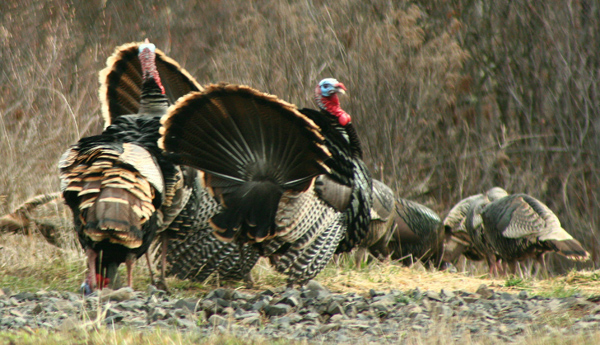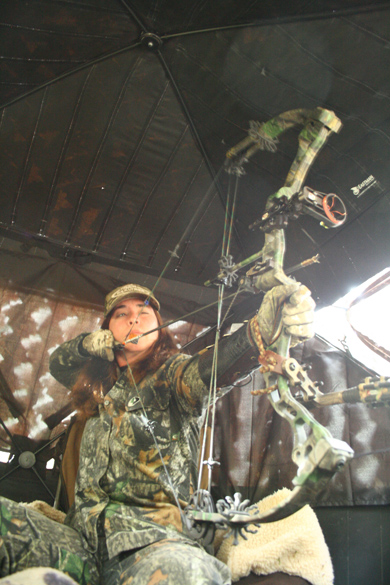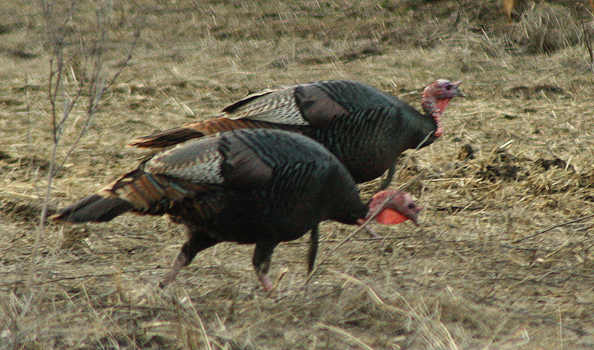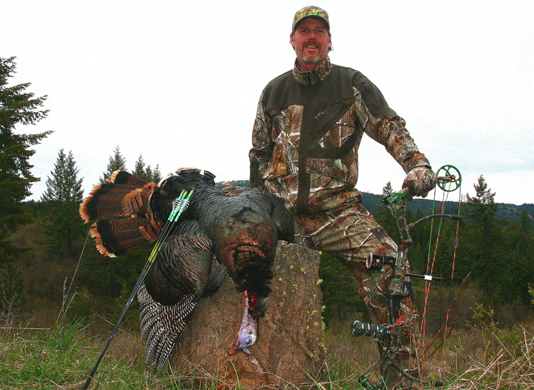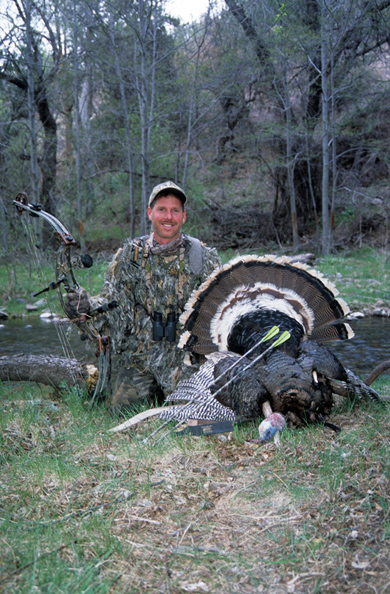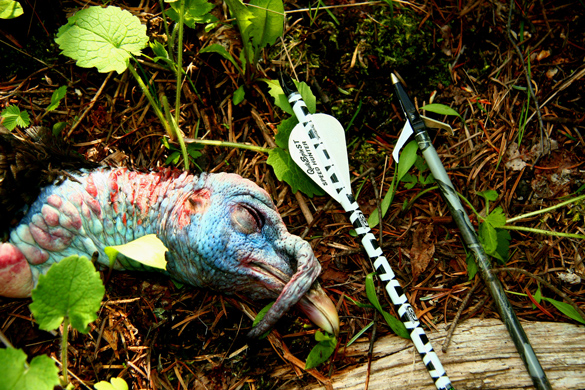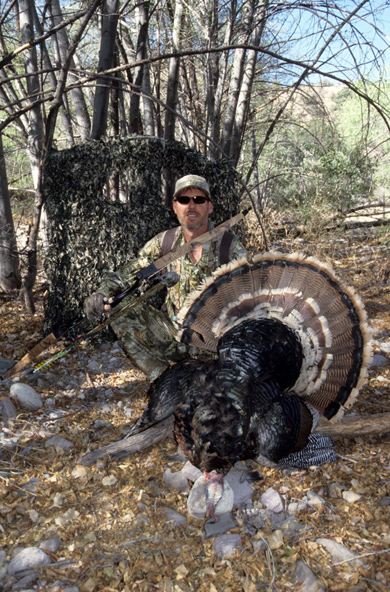LAST UPDATED: May 1st, 2015
Hard-won advice on choosing the ideal bow, arrows and broadheads for spring turkey
I’ve arrowed 62 turkeys to date, using everything from a 73 1/2-inch, self-made primitive bow, modern recurves, longest axle-to-axle finger bows to the shortest compounds made. I’ve tagged enough gobblers with bows to understand what works and what doesn’t, but more importantly to our discussion here, what type of set-up helps you become the most efficient turkey hunter possible. I mean turkey hunting with bow’s difficult enough; why handicap yourself with ill-suited gear – unless out to intentionally add to the challenge, as I was doing while using trad gear? Of course any time you label something “ideal” you’re delving into the subjective, but in general terms the advice to follow will serve the largest percentage of average bowhunters.
Even the biggest spring gobblers offer vital areas no bigger than a baseball. Not only does this demand shot less than 30 yards, but a broadhead wide enough to turn marginal hits into killing ones
Concerning Bows
It’s first important to consider the conditions you’ll most often be facing in turkey woods. Physical stature also comes into play as well. Most important, turkeys are normally shot from inside a portable pop-up blind (most common today) or while sitting flat on your rear while hunkered in natural cover. For average guys shooting from inside a pop-up with bows measuring more than 36 inches between the axles takes a cool head to assure everything will clear before releasing a string. Sitting flat on your rear while shooting can cause further clearance problems with longer bows. For those reasons turkey hunting’s the only time I endorse short bows.
Shooting from inside a pop-up blind offers challenges of its own. The bow shouldn’t be so long it contact the blind’s roof, but in direct regards to turkey, not so short it’s difficult to shoot well.
“Short” is relative to stature. I’m 6-foot, 5-inches tall. For me short is 36 inches. My wife, standing only 5-foot, 3 inches, would have a difficult time clearing the ground with such bows while sitting flat on her rear. Conversely, because of my stature, shooting a 36-inch bow inside a run-and-gun pop-up can pose potential clearance problems. For the sake of simplicity, and brevity, let’s call 32 to 35 inches axle-to-axle an ideal happy medium for turkeys.
Turkeys make a challenging target no matter the range. They offer small vitals and are always moving. A smooth-drawing, forgiving bow will result in more successful shots
You may ask, “Why not shorter; considering the stipulations under discussion?” For most shooters it’s a matter of forgiveness. Though sure killing range on turkeys for most of us is only 20 to 30 yards, there’s still no way around the fact turkeys offer baseball-sized vitals and seldom sit still. For most of us, shots at turkeys are also taken under pressure. The 32- to 35- threshold is one providing perfect balance between shootability (forgiveness) and maneuverability. Forgiveness also correlates to brace height. Sub 7-inch brace heights produce burning speed, but make bows inherently touchy to shoot (especially under pressure) because arrows remain on the string longer after release, providing more opportunity to introduce human error (like dropping the bow arm, for instance). Lastly, look for silky-smooth cam systems. Sitting – on the ground or in a pop-up stool – can make it more difficult to break over a radical cam; and any added struggle to reach anchor will not go unnoticed by Mr. Tom (a drop in bow poundage is also a good idea).
Author Patrick Meitin shot this handsome spring gobbler with a short Bear Archery compound and an aggressive mechanical broadhead. The bird traveled only 15 yards after impact and died on his feet
In quick review: 32- to 35-inch axle-to-axle, 7- to 8-inch brace height and smooth-drawing cams and/or bow poundage you can pull straight back slowly and evenly without lifting or twisting the bow arm while sitting.
Arrow Choices
There’s not really a lot to relate here. The heavy arrow used for elk will work just fine for turkeys. So will the super-light arrow used for thin-skinned pronghorn or 3-D targets. There are certainly no penetration issues, and speed isn’t an issue as turkeys don’t jump the string. My only concern when choosing a turkey arrow is camouflage. Turkeys live by their eyesight. They also perceive the full color spectrum (unlike cervids — deer and elk — which see only in various shades of black, white, yellow and blue). Turkey hunting’s the only time I obsess about camouflage arrows — otherwise they’re difficult to track in flight (providing clues to shot placement) and a pain to find after a miss or while stump shooting (which I enjoy doing even while seriously bowhunting). My only complaint about even the sharpest camo-arrow finishes is some are shinny due to coatings applied to make them easier to pull from foam targets. I’ve found that scuffing them with steel wool helps knock down this turkey-spooking shine.
After a two-hour calling session the author finally got his shot at this huge New Mexico Merriam’s gobbler, forced to draw in plain sight. A Rancho Safari Shaggie outfit and camouflage arrows made all the difference
This isn’t to say plain black carbons are taboo for turkey it’s just that I seek every edge possible in regards to turkey and if nothing else, camo arrows give me confidence I’ve done everything possible to make myself inconspicuous. One area often neglected here are fletchings. Put bright fletchings on camo arrows and you cancel all camouflaging benefits. In big-game hunting I prefer bright fletchings (and glaring wraps). I want to know where I hit an animal after release. When assembling spring turkey arrows I apply green-barred feathers or vanes in green, black and brown hues. I can always strip them off and refletch them before fall seasons…
The Broadhead Is Everything
I arrowed my first bow turkey way back in 1979. Things were a bit different back then. Replaceable-blade broadheads were still a new concept and turkey hunting with bow was considered a parlor trick. The biggest problem was standard big-game broadheads have a tendency to zip right through turkeys, leaving a relatively-small hole behind, and giving even perfectly-hit gobblers just enough time to fly off a high ridge or burrow into thick brush. Regrettably, in those early days I only recovered maybe one in three gobblers shot. Of course we tried things like adding washers behind broadheads, but eventually understood shock isn’t the goal — punching a damn big hole is.
New Archery Products’ Gobbler Getter includes a blunted tip to impact shock on impact, but also 1 ½-inch cutting diameter to create a massive wound channel. Punching that big hole is what is most vitally important in bowhunting turkeys
Enter the mechanical broadhead. Since adopting wide-cutting mechanicals, those with cutting diameters from 1 ½ to 2 inches (sometime wider), I can honestly say my loss rate has been reduced to, say, one in 12. I’ve gone something like 21 birds in a row without losing a single bird. Forget the entire notion of imparting shock – a concept I still see a few manufacturers focusing on. It’s all about cutting a devastating wound channel – one that proves fatal even on marginal hits, such as gut shots. Putting it in more indelicate terms; shoving a 2-inch mechanical through even a gobbler’s guts is parallel to pushing a shovel through a man’s stomach. He’s gonna die, pure and simple.
Even when choosing traditional gear for turkey hunting, as author Meitin often does, the rules of a wide-cutting broadhead design still apply. The author used a 1 ½-inch-wide G5 Striker Magnum to cleanly take this gobbler
You don’t have to look far today to find deadly turkey heads, but some of my favorites include NAP’s Gobbler Getter (blunted tip to impart shock and 1 ½-inch cutting diameter) and Spitfire Edge Maxx (1 ¾-inch with serrated edges that saw through heavy wing feathers), Trophy Ridge Hammerhead (2-inch), Rage Xtreme (2.3-inch) and Grim Reaper Razortip Extra (1 ¾-inch). Flying Arrow Archery’s new Tom Bomb (125 grains with 2 ½-inch curved, scythe-like blades that work with fletching for great flight) and G5’s Striker Magnum (125 grains, 1 ½ inches) make good choices in states where mechanical heads aren’t legal.
Tagging turkey with bow and arrow’s no longer considered a parlor trick. More bowhunters every year are discovering the great fun to be had in spring woods by leaving the shotgun at home and adding a new dimension to their turkey-hunting pursuits. Success is easier than you likely believe, but starts with the right outfit. Take the tips offered here and you’re well on your way to a winning spring season this year.

 By
By 